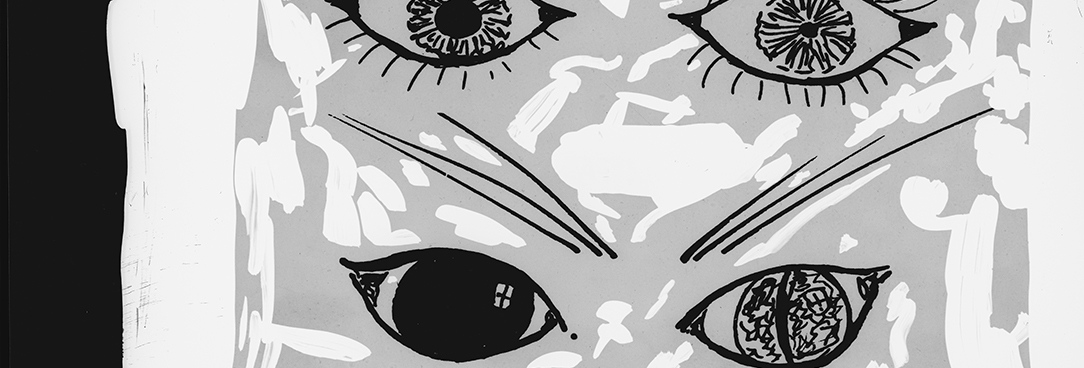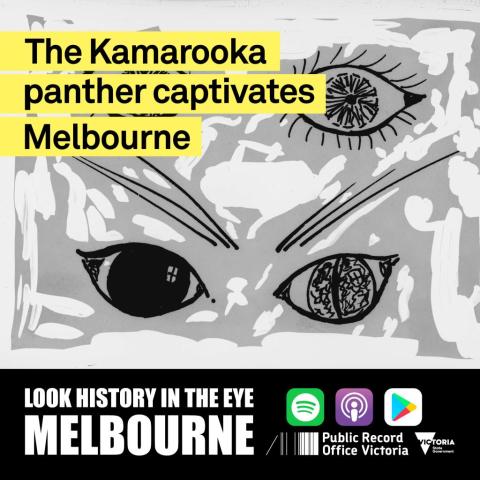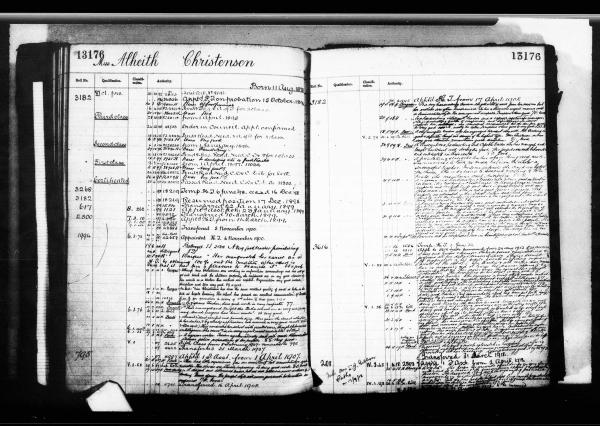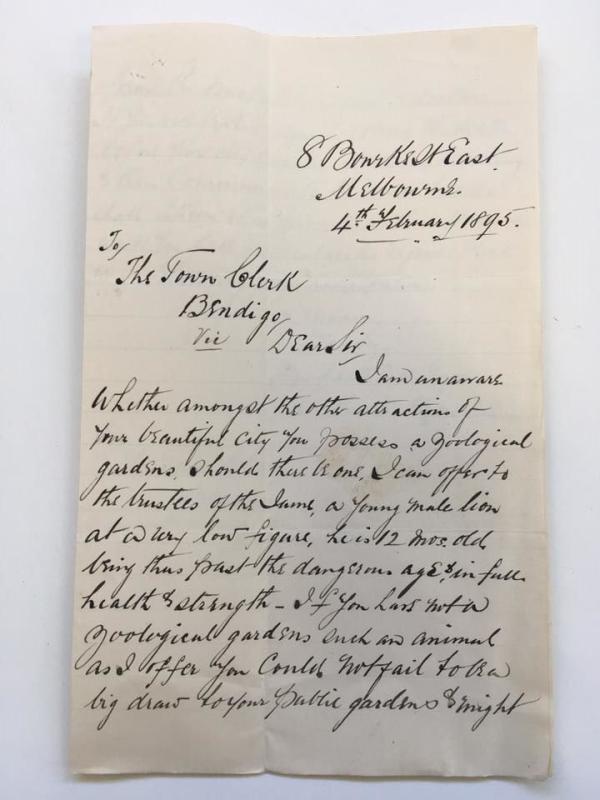Transcript episode 8: The Kamarooka panther
Duration 17 min
From the podcast series 'Look History in the Eye'
Written, produced and present by Tara Oldfield and Public Record Office Victoria
Music and sound design by Jack Palmer
Guest: Desiree Pettit-Keating
Desiree Pettit-Keating
It certainly wasn’t the first sighting or suspected big cat in the Bendigo and Goldfields area. There’d been a couple of instances where goats or sheep had been killed, and various people in the community had said that they’d seen a tiger or lion or some other variety of big cat. But this is the one that they’ve picked up and ran with it a bit.
Tara Oldfield
It’s 1907, a Thursday in late January, sisters Alheith and Trine Christensen are driving through the Whipstick to the family farm at Kamarooka.
Climbing a crest some 18 miles north of Bendigo, they see what they initially think to be a fox atop the hill. The animal appears to have no fear as it approaches their buggy. The women, terrified, rush home to the farm to tell their family of the animal which they have determined to be no fox at all. Three-to-four feet in length with a long tail, thick neck and head, like a cat about the nose but more oblong, about 24 inches tall with a glossy brown body and lighter undercarriage, and walking “in a sneaking attitude and gait.” The sisters are convinced that they have faced a panther.
But are they credible witnesses?
You’re listening to the Podcast “Look History in the Eye” produced by Public Record Office Victoria, the archive of the state government of Victoria. Where over one hundred kilometres of public records about Victoria’s past are carefully preserved in climate controlled vaults. We meet the people who dig into those boxes, look history in the eye, and bother to wonder… why.
I’m Tara Oldfield, the Communications Advisor at Public Record Office Victoria. Last year my colleagues and I covered quite a few Melbourne stories for Look History in the Eye, from Coburg prison escapes to Melbourne monuments that never came to be, but what about the stories further afield that captured the attention of Melburnians of the time?
Teacher records, local council correspondence and inquests from across Victoria can be found in the state archival collection, with many Bendigo records available through the Bendigo Regional Archives Centre located at the Bendigo Library. Such records, along with newspaper reports of the time, reveal the story of the Christensen sisters, their family, their work as teachers, and their strange experience with a mysterious creature known as the Kamarooka Panther. The story gripped Melbourne with newspapers reporting every sighting of the roaming panther and the search parties scouring the scrub in the regions of Victoria.
Desiree Pettit-Keating is the Bendigo Regional Archives Centre Officer. She began researching the Kamarooka Panther in 2019, inspired by Dr David Waldron’s work on big cat folklore and panther sightings throughout Australia.
Desiree Pettit-Keating
About half way through 2019 the Bendigo Regional Archives Centre or BRAC as we’re referred to, celebrated ten years in operation. And so we decided that that warranted a bit of a party and how else do archivists party except to get other archivists up to talk to people. So we had the wonderful David Waldron, Dr David Waldron, from Federation University and he came up and gave a talk titled Phantoms, Panthers and Mystery Airships and it was about folklore on the goldfields. And specifically he spoke about the Tantaloona Tiger which was a suspected big cat over Mount Gambier in 1893 and he spoke about that. Afterwards we thought, hmmm, did we maybe have our own tiger? And yes we did. We had the Kamarooka Panther.
Tara Oldfield
According to Waldron, reports of large cat-like predators emerged in Australia during early settlement in the 1830s. But it was the Tantanoola Tiger that spurred Australia’s largest big cat panic. The story of the Tiger in Tantanoola South Australia originated in the 1880s and continued to gain steam well into the 1890s and beyond with sightings of an enormous tiger-like black and yellow beast, cat tracks, and live stock deaths. In 1895 two men shot and killed an animal they claimed to be the Tantanoola Tiger but some weren’t convinced and big cat sightings have continued ever since.
And so, from the Tantanoola Tiger we fast forward twelve years and trek across to the Bendigo region of Victoria where the Christensen sisters live with their family near Kamarooka.
Desiree Pettit-Keating
Kamarooka was a little township north of Bendigo so if you travel north of Bendigo you reach an area called Huntly and if you veer off to your right you head towards Echuca and Elmore, and if you head straight north and continue on, you’ll reach Kamarooka.
The two sisters, there was seven siblings. Alheith was the eldest daughter and Trine was the youngest daughter and then there were two younger brothers after them. They lived in a district that’s called Drummartin which is a little bit north east of Kamarooka. And they were traveling down to Bendigo with a horse and carriage. They were teachers, they were both teachers. Five of the seven siblings actually ended up being, training as teachers. We see from the inspectors reports that they were, you know the descriptions that the inspector gives of the sisters in their teaching practice, they use words like vigorous, sorry rigorous, careful, painstaking, thoughtful, intelligent, careful and hardworking. Their students were getting really good results even in the smaller schools they were sweeping scholar prize lists. So they were clearly very very good at what they did. They were the children of Tobias and Maria Christensen who’d come out from Denmark and there’s quite a few Danish and Scandinavian families that settled in the district at that time and so they lived on a hundred and fifteen acres at Drummartin and they were heading into Bendigo obviously being the nearest larger centre to Kamarooka.
We see in an inquest when the girls father died Alheith was 17 at the time, she actually found her father, and you can see from her deposition from the inquest that she’s very observant she’s very articulate.
Tara Oldfield
In 1907 the sisters were aged 23 and 29. That year the eldest Alheith was promoted from the Patho State School to the Rochester State School after just one term. Described as a teacher with few equals, with her scholars sweeping prize lists at all competitions where they were virtually unbeaten. Such was the regard for her ability in tuition that the Patho school community put on a farewell social where they presented her with several gifts, including a dagger brooch set with pears and rubies. In January the sisters were driving from the Whipstick to Bendigo with their horse.
Desiree Pettit-Keating
Now the road I imagine, and again I haven’t looked at maps for this, but I imagine it’s quite similar to what it would have been at that time because it does cut through what’s now the Whipstick State Forest. So it’s a fairly substantial area of woodlands and this road cuts right through the middle of it. So there’s very few roads and intersections that come off it for quite a long stretch. It’s a fairly straight road, it is quite undulating so there’s a lot of crests and a lot of falls as you’re driving along it. And the Whipstick is basically it’s an ironbark forest but there’s a lot of low scrub so wattle bushes all sorts of acacias and melaleucas and what have you. It’s quite a dry area, and it certainly would have been at that time. There’s a bit of eucalyptus distilling going on in that district, along with a little bit of mining, but mostly sheep, cropping, that sort of thing. So you leave Bendigo and then you hit the Whipstick Forest and you come out the other side and you’re in cropping flats which is Kamarooka. As they were coming up a hill they saw a silhouette on top of the hill and they took it initially to be a fox. But as they started up the hill this animal started to come down toward them. They said it stopped and observed them before it went into the scrub. It didn’t seem to have any fear of them, and it started stalking them for a little while. So when they were asked to describe what the animal looked like up close, they said it had a body of about three to four foot long, had a long tail, had a thick neck and a head that was very feline in profile, it stood about twenty inches at the shoulder, it was a glossy brown colour, and it walked with a sneaking attitude which I think is a brilliant, such an evocative description. So they kept going, they hurried on as I guess you would in that situation and coming back they actually didn’t go via this very direct road back to Bendigo. They’d been sort of so shaken by the experience that they went the long way round, and it was really quite a long way round so it obviously really impacted on them.
Tara Oldfield
The Melbourne and interstate newspapers were transfixed by the encounter.
Desiree Pettit-Keating
Not just Melbourne but actually beyond we were seeing a lot of interstate coverage as well which is interesting. So we see things like panther scrub scare, a dangerous animal, and then we get a little bit of more hyperbole with chased by a panther. And there’s a description of these women being chased for a mile by this animal which is a bit at odds with the description we read first in the Addy. So within days there’s other people coming forward to different papers to share their own experiences insisting that they’d seen something in the Kamarooka district. People started carrying firearms so we see reports of what’s going on as time progresses. There’s search parties that are put out to try and find what it might be as well. So we’re getting reporting not just of the initial incident but also what’s happening as time’s moving.
Voices
“Wild beasts at large!”
“The panther, or tiger, which is said to be at large in the Whipstick scrub seems to be getting more and more daring.”
“Something like a mild scare has been caused here through the reports of a panther being seen in the Whipstick, and most of those who have occasion to travel through the scrub to Bendigo say that they will carry firearms in their vehicles.”
Tara Oldfield
Theories about the origins of the Kamarooka Panther abounded. Could it be connected to the Tantanoola Tiger of South Australia? Or an escapee from a menagerie? Or just some feral dog or cat? Or maybe something altogether mystical, unexplainable, undiscovered?
Desiree Pettit-Keating
The main theory seemed to be it was a big dog of a strange variety and that’s a quote from one of the reports. There’s a number of mentions that there was a circus and a menagerie that had come through twelve months earlier and that they’d camped in the district and it was quite possibly an escapee from their collection. Some claimed it was too big to be a panther, others claimed that they’d seen it and said that it was shaped and marked more like a tiger. Again, we had that report from Sydney on the same day as the panther report about lions escaping from a circus in Sydney. And we do see that happening quite, not regularly but certainly not irregularly that there would be animals with traveling circuses and menageries that would escape from those places. One paper suggested that despite the initial sightings from 1895 of the Tantanoola tiger, that it was actually the same tiger. That it had travelled up from Mount Gambier to Kamarooka. And there was an orchardist at Epsom which is a bit closer into Bendigo who claimed that he had a dog that was big and peculiarly marked and that it had broken it’s chain a couple of weeks earlier and he thought that that might have been what was causing the sightings.
Tara Oldfield
Desiree did some digging and discovered that about one year earlier there was in fact a circus that came through town, so could this be the most credible story of the bunch?
Desiree Pettit-Keating
If we go through we can find a listing of the animals that they had with them. Now among I think something like 20 lions, they had bears, they had a chimpanzee, they had tigers, they had a polar bear, they had a hyena, they also had a puma and they had a cape lynx which if you have a look at a cape lynx which is also referred to as a carical, you could easily mistake that profile for a fox I think. And again it fits the description. It’s about the right size, it’s about the right colour, it's the right face shapes, so I think there’s certainly no reports of an escapee of a lynx or a puma while they were in town but I think given that there were so many of these groups traveling around it's you know, it’s not outside the realms of possibility that they may have actually seen a big cat.
Tara Oldfield
Similar theories had been posited about the Tantanoola Tiger years earlier with historian and botanist Neville Bonney claiming that a collision between circus caravans in 1883 set a pair of tigers loose on the road between Robe and Mount Gambier. While the Tantanoola Tiger story was somewhat resolved by a purported shooting of the animal, the locals appeared to have had no such luck locating the Kamarooka Panther. Not according to the papers in any case. And so sightings continued. As late as 1915, a large animal reported by farmer John Comer as looking like a tiger or leopard was seen in Mandurang, coming through the scrub and then heading toward the Maloney and Semmen farms. Locals thought it may have been a pig, but Comer was adamant that the animal walked with a stealthy, springy stride just like a tiger and was striped like that animal. Local superintendent of police, Arthur Dungey, was sceptical it was the Kamarooka Panther, suggesting that if the creature was still alive:
Voice
“It’s a very old bird by now. If anyone can lay low that ferocious mythical beast of prey… he will win the undying gratitude of every member of the force!”
Tara Oldfield
Life for the Christensen sisters, meanwhile, went on.
Desiree Pettit-Keating
They continued to teach. They had the younger brother who went and studied a Bachelor of Education in Melbourne and came back. They mostly taught in the district and a little bit beyond so over towards Echuca. The younger brother Christian who was a very good teacher as well, he was killed in the first World War, and the whole family were very very strongly engaged in a lot of that war relief effort, funds raising and things like that in their own district.
Tara Oldfield
Sightings of big cats have continued to captivate, often with the theory of escape from a menagerie or circus some years earlier attached.
Desiree Pettit-Keating
I just find it was really interesting that the whole idea about there was a circus and it was an escapee, and when we look back there actually, that was actually happening, there was a circus and we do have examples of you know animals escaping. There were certainly a couple of years later in Bendigo one of the elephants from Wirth Circus got away and it smashed up a whole heap of shop fronts and it took them hours to get it under wraps and back into their troop down to the train station down to Melbourne. This particular circus the same year that they were in Bendigo, when they reached Castlemaine they had a baboon escape so I just find it really interesting that these theories that people are coming up with these actually evidence that well you know there is something to this after all.
I don’t know I think if someone today said I saw a wild cat then I’d be fairly incredulous but I think at this time with all of these reports, and as I say, this is happening in London it’s happening in New York, it’s happening in Sydney, it’s happening in Castlemaine, so these are things that are actually happening so I think at this particular time, there might be a little bit of truth to it perhaps. It’s a nice idea anyway.
Tara Oldfield
Thank you to Desiree Pettit-Keating for sharing this story from the Bendigo Regional Archives that so enraptured Melburnians of the time.
For those interested in exploring this topic further, look no further than Dr David Waldron’s book with Simon Townsend, Snarls from the Tea Tree: Australian Big Cat Folklore. A big thank you to David for inspiring Desiree’s research and for sending me through some of his own research for this podcast.
Learn more about the records featured in this story by heading to our episode page at prov.vic.gov.au.




